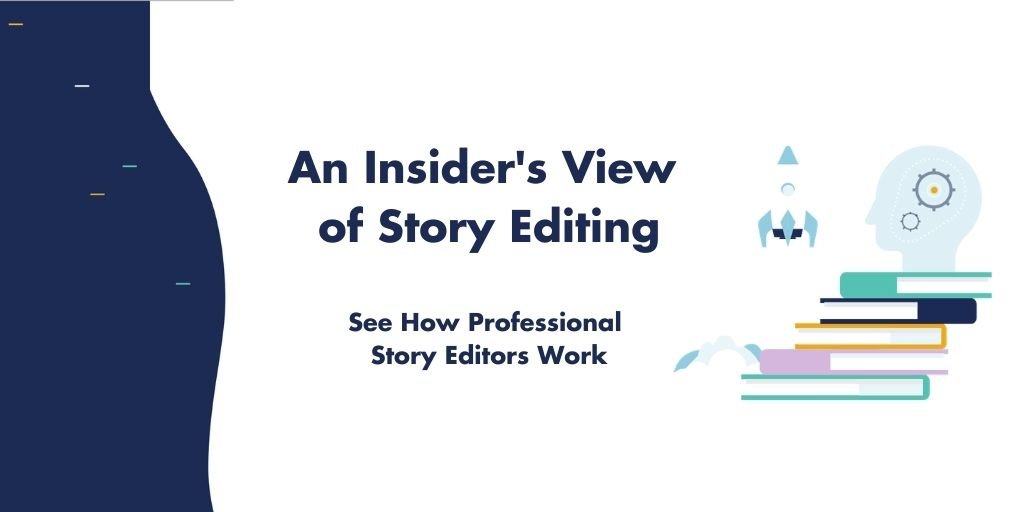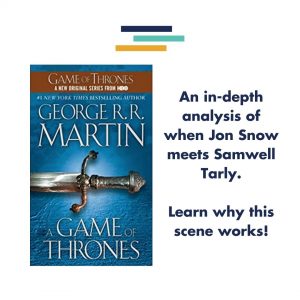
The Fictionary Story Arc and the Story Elements together show you why a scene is working or not working.
In his discussion on a storytelling model, Larry Brooks says:
“What seems to be lacking […] is a defined process that embraces all requisite elements and underlying principles of a good story.” – Story Engineering, Larry Brooks, p. 11
He goes on to say,
“[…] the resulting product may or may not be everyone’s cup of tea, even if it’s structurally sound. That’s the art of it.”
I’m going to show you a scene that is structurally sound AND artistically written by evaluating it against the Fictionary story Elements to demonstrate the elements required to make every scene great. If you’re familiar with the story elements, you’ll know some apply at the scene level and some apply at the story level. We’re looking at the scene-level elements.
One of my favorite scenes in a novel is Chapter 26 (scene 27) of A Game of Thrones: A Song of Ice and Fire by George R. R. Martin. This is the scene where Jon Snow meets Samwell Tarly at the Wall. I love this scene because it utilizes almost all of the scene-level 38 Fictionary Story Elements, and it’s an excellent example of a brilliant scene structure combined with artistry.
I’ve analyzed the scene to show you how you can analyze your own scenes, or if you’re a professional editor, to analyze a scene in a client’s novel.
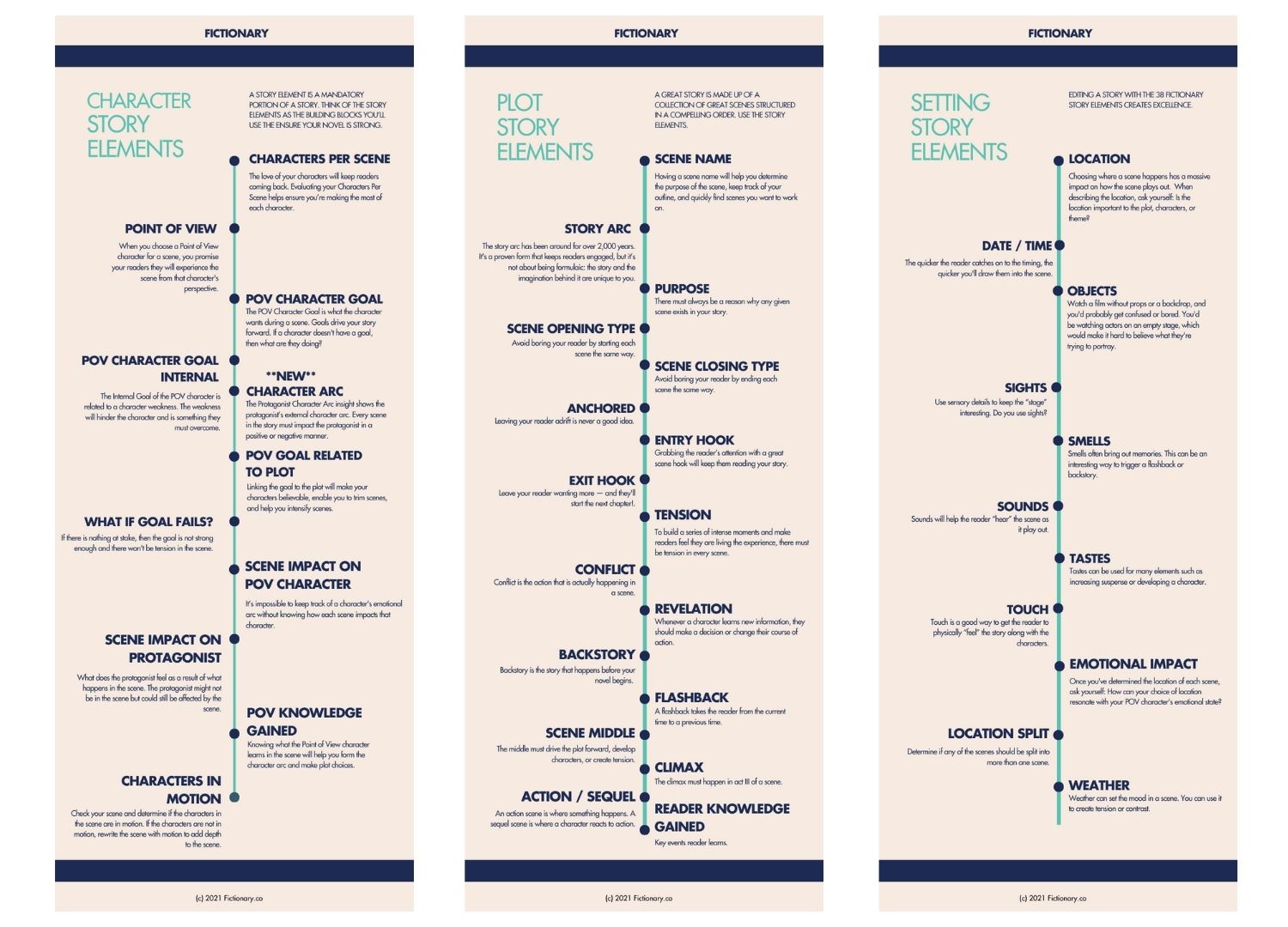
Chapter 26: A Game of Thrones: A Song of Ice and Fire Scene Analysis
Each chapter of Martin’s novel contains one scene, and each scene is written from a single point of view. He uses nine points of view throughout the novel.
In the scene in chapter 26 , Jon meets Samwell, saves him from a bad beating, and the two become night watch brothers by the end of the scene.
This scene occurs after the overall story’s plot point 1 and before the middle.
![]()
A Game of Thrones Story Arc Refresher
Let’s put Chapter 26: Jon in the context of the overall story arc for A Game of Ice and Fire.
Inciting Incident
Catelyn tells Ned that Jon, Hand of the King, is dead. This is the first change in the ordinary world of the kingdoms. The impact on the world is negative as this kicks off the battle for the Iron Throne.
Plot Point 1
Catelyn meets Ned at King’s Landing, and they stick together and are going against the Lannisters because of an attempt on Bran’s life.
Chapter 26, scene 27 occurs here.
Middle
Jon takes action to get Samwell into the Night’s Watch. Tyrion bribes to get safe passage. Ned acts for the King. All three key characters on the side of the humans get proactive and start to drive the story forward.
Plot Point 2
Ned will send the Kingdoms to war, and this is bad for the Kingdoms as it weakens them against the Others.
Climax Sequence
Ned Stark is executed by Joffrey, Arya becomes a fugitive, and the War of the Five Kingdoms begins. There are three scenes and three point of view characters during the climax sequence.
Ned being executed is bad for the Kingdoms because the Starks cannot turn away from battling the Lannisters. The war begins is a negative impact on the kingdoms. The point of view characters are all affected differently. Some positive and some negative, but the world is heading into chaos.
Resolution
Dynaerys loses her son, kills Khal Drogo, and gives birth to three dragons. This is positive for the Kingdoms because the dragons are needed to defeat the Others.
![]()
The Structure of a Scene
First, let’s evaluate the scene from the structural level using six of the Fictionary story elements.
We’ll use the entry hook, scene name (inciting incident), conflict (plot point 1), middle, climax, and exit hook.
Entry Hook: Who is the new recruit?
Martin uses dialogue for an entry hook. Dareon stops sparring with Jon to say,
Dareon broke off and lifted his visor. “Seven Gods,” he murmured. “Would you look at this, Jon.”
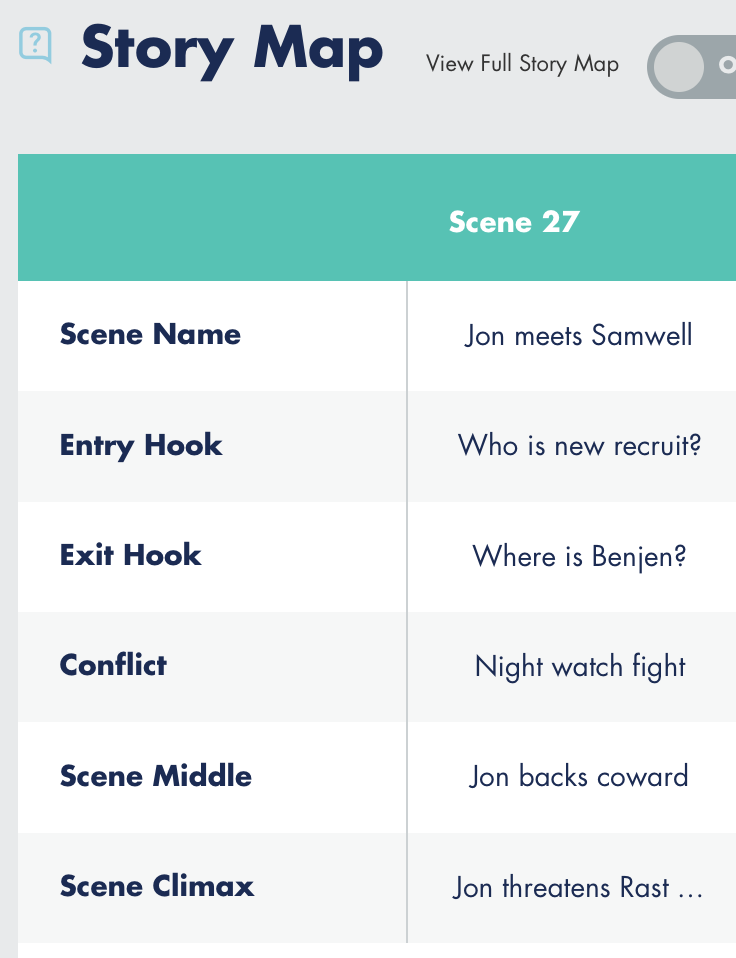 Scene Name: Jon meets Samwell
Scene Name: Jon meets Samwell
Samwell arrives and the others realize he’s a lordling and he’s over weight. Note this is also the inciting incident for the scene. The inciting incident is often a strong way to name a scene. This gives the scene name a dual purpose. You’ll know what the scene is about, and you’ll know the scene has an inciting incident.
Conflict: Jon disobeys an order from the commander at arms, which kicks off the fight to protect Samwell.
The start of the main conflict is also plot point 1 of the scene. Once Jon goes against the commander at arms, he can’t turn back from that action. Pyp has been trying to stop Jon from protecting Samwell, but when Jon can no longer stand it, he takes action to stop Halder from beating Samwell.
Jon shook off Pyp’s hand. “Halder, enough.”
Middle: Jon has backed a coward
Jon’s team has stepped up to help him and it turns out they’ve backed a coward when Samwell says,
“I wanted truly. I just… I couldn’t. I didn’t want him to hit me anymore.” He [Samwell] looked to the ground. “I…fear I’m a coward. My lord father always said so.”
Climax: Jon uses Ghost to scare Rast
Jon is determined to protect Sam. To do that, he must have others on his side. Rast refuses, and Jon shows his strength and willingness to hurt another when he takes ghost to scare Rast.
Jon could hear Rast’s rapid breathing as Ghost leapt onto his chest. The direwolf’s eyes burned red as embers as his teeth nipped lightly at the soft skin of the boy’s throat, just enough to draw blood. “Remember, we know where you sleep,” Jon said softly.
Exit Hook: Where is Benjen Stark?
Jon and Samwell are brothers, showing how important the other nights are to Jon.
“We’re not friends,” Jon said. He put his hand on Sam’s broad shoulder. “We’re brothers.”
Jon succeeded in having none of the brothers harm Samwell. This leads to Jon worrying about his uncle and whether he’ll be able to tell him he understands the value of the night watch brothers.
I’ve included the entry and exit hooks because at the scene level, they are key to keeping the reader engaged and reading. Without hooks, the start and end of each scene is a potential place for the reader to stop reading.
The Fictionary Story Elements
Character Story Elements
Point of View (POV):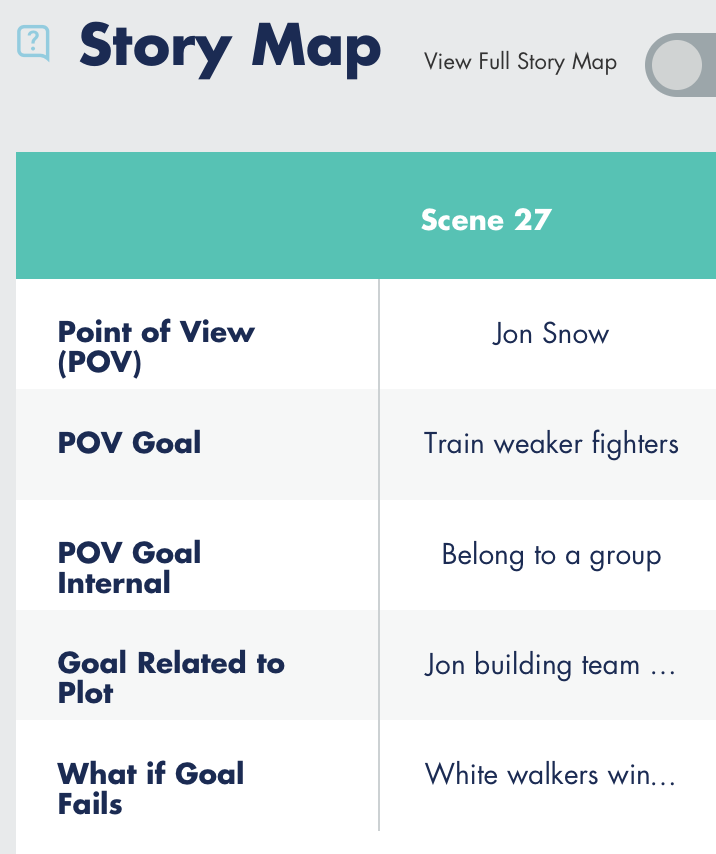 Jon Snow
Jon Snow
Game of Thrones: A Song of Ice and Fire has 9 point of view characters. This scene gives us insight into who Jon is.
POV Goal: Train weaker fighters
The goal is clear in the first paragraph of the scene. It has a dual purpose. To show Jon’s goal which gives the reader something to cheer for, and to show Jon cares about others.
The opening sentence shows the goal. It also shows us they are in the practice yard (location), Jon is teaching, and a new recruit arrives.
Jon was showing Dareon how to best deliver a sidestroke when the new recruit entered the practice yard. “Your feet should be farther apart,” he urged.
POV Goal Internal: Belong to a group
The internal goal is often harder to spot than the external goal. It’s not until we’ve read the scene that we understand Jon has a need to belong which grew from being brought up as a bastard child and having Catelyn (his father’s wife) hate him.
Goal Related to Plot: Jon is building a team of fighters
As A Game of Thrones progresses through the series, Jon is going to need strong fighters by his side in order to beat the white walkers. The goal is strongly related to the plot.
What if Goal Fails?: White walkers win and Jon will die
Having a goal without consequences means the goal is not related to the plot, and it’s not strong enough to keep the readers engaged. In this scene, if Jon fails to train a strong group of fighters, they will all die. This goal will continue after this scene, and Jon doesn’t succeed in the scene, but he has started. The reader still doesn’t know if he’ll succeed or not, so this keeps tension in the story.
Plot Story Elements
Scene Name: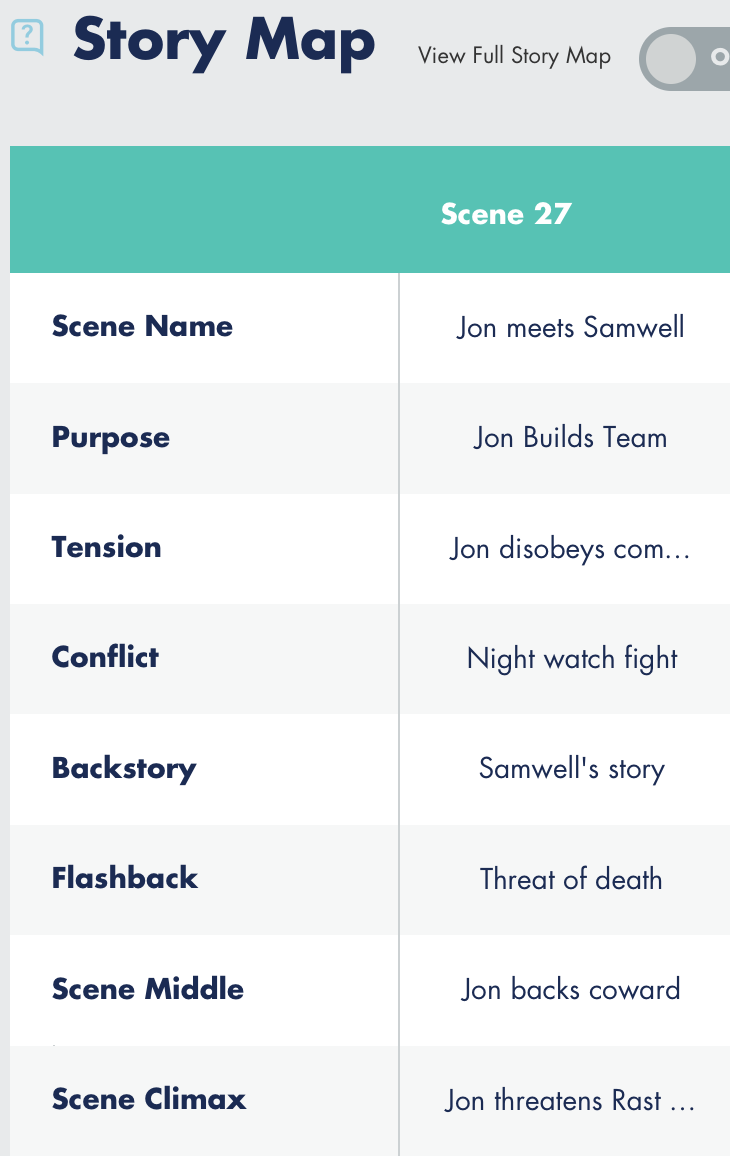 Jon meets Samwell
Jon meets Samwell
Purpose of Scene: Jon builds team
As the plot progresses, the Kingdoms will fail in their battle against the Others. The purpose of the scene is to show readers where the night watch is starting from and how hard it will be for them to defeat the Others. Jon must build a strong team, not just of fighters but of thinkers.
Samwell is the thinker. Samwell can be thought of as a mentor as he brings needed knowledge to Jon later in the story.
Tension: Jon disobeys commander at arms
The reader already cares about Jon and now expects something bad to happen to him. It hasn’t happened yet, but the tension is there. By the end of the scene the reader will also care about Samwell. Another source of tension as the story moves forward.
Conflict: Night watch fight
This is the fight actually happening. The men are engaged in a battle to attack or protect Samwell.
Backstory: Samwell’s story
One of my favorite techniques used in this scene is how Martin uses backstory.
There is great use of backstory in this scene. Samwell’s family sword is planted as a key object that will be used later in the series..
The backstory is interwoven throughout the scene using thought, dialogue, description and flashback (as mentioned below).
Backstory shown in thought:
Jon has just told Samwell they are brothers, not friends. Then the scene is rounded out with backstory via thought. Martin is reminding the reader Jon is a bastard and who the other sons are.
And so they were, he [Jon] thought to himself after Sam had taken his leave. Robb, Bran, and Rickon were his father’s sons, and he loved them still, yet Jon knew he would never be truly one of them.
Backstory shown in dialogue:
Samwell is telling Jon who he is and where he’s from.
“I mean, I was of Horn Hill, until I . . . left. I’ve come to take the black. My father is Lord Randyll, a bannerman of the Tyrell’s of High-garden. I used to be his heir, only . . . “
This section of dialogue confirms Pyp was right that Samwell is from High-garden. It shows the reader Samwell was an heir and leaves the question of why he’s no longer an heir and why has he come to take the black.
Backstory shown through description:
This portion gives Pyp’s backstory following his declaration of where Samwell is from.
Pyp had travelled the Seven Kingdoms with a mummer’s troupe, and bragged that he could tell what you were and where you’d been born just from the sound of your voice.
There is a dual purpose here. Martin shows the reader Jon listens when others talk and it makes Pyp’s previous statement that Samwell is a lordling from Southron near High-garden.
Flashback: Samwell’s father will kill him if he doesn’t take the black
This backstory was told in a flashback (an active scene that feels as it it’s been told in the present.) Samwell’s story begins with summary and dialogue. Then when the highest emotional impact of the backstory is about to happen, Martin switches to a flashback.
The following is the lead-in to the flashback.
Until the dawn of his [Samwell’s] fifteenth name day, when he had been awakened to find his horse saddled and ready. Three men-at-arms had escorted him into the woods, where his father was skinning a dear.
The flashback starts here
“You are almost a man grown now and my heir,” Lord Randall had told his eldest son, his long knife laying bare the carcass as he spoke.”
Samwell’s father then goes on to tell him he’ll kill him if he doesn’t take the black and forsake his inheritance. The lead-out of the flashback is
Sam told the tale in a calm, dead voice…
The scene then transitions to a new location giving the reader a chance to take in Samwell’s horrible past before they move on to the next dramatic moment. This happens at about 80% through the scene and is similar to a novel’s plot point 2 where a character is at their worst.
The artistry of storytelling shines through here. Martin knew exactly when to use a flashback for maximum impact.
Scene Middle: Jon has backed a coward
This is a turning point for Jon. He decided to defend Samwell, and the others believe it was the wrong choice. Jon must use all of his leadership skills to convince the others to protect Samwell. His group expresses their unhappiness as follows
When he [Samwell] was gone, Grenn frowned. “Nobody likes cravens,” he said uncomfortably. “I wish I hadn’t helped him. What if they think we’re cravens too?”
Scene Climax: Jon threatens Rast using Ghost
Not all agree to protect Samwell. Jon, along with Ghost, physically threatens Rast unless he goes along with what Jon wants. Jon shows he can lead with both kindness and with strength.
Setting Story Elements
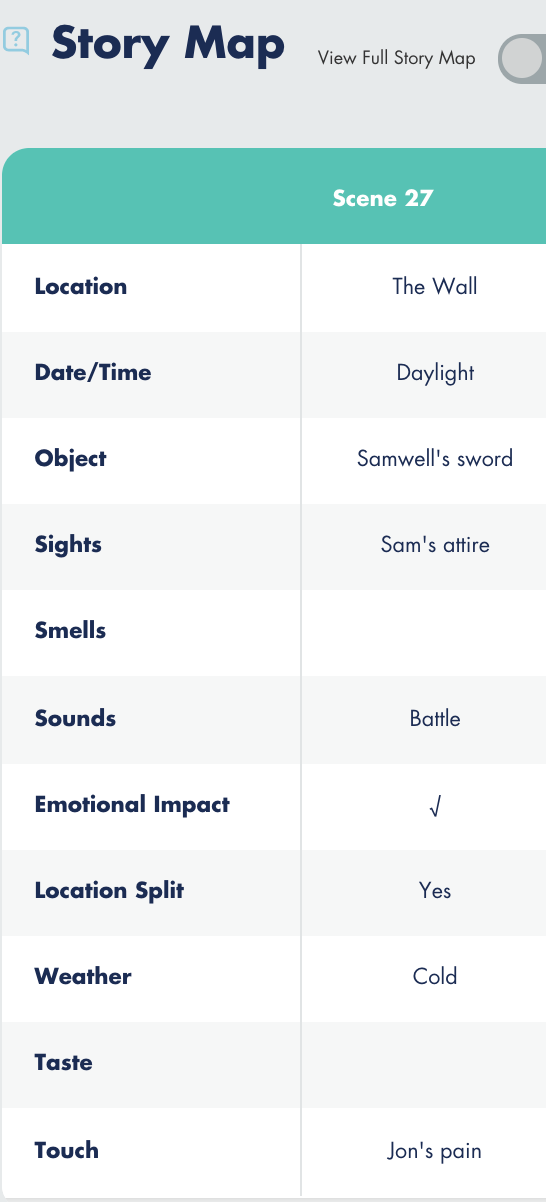 Location: The Wall
Location: The Wall
The location is where the scene takes place. Choosing where a scene happens has a massive impact on how the scene plays out.
When describing the location, ask yourself: Is the location important to the plot, characters, or theme? If it’s not important to any of these three, choose a different location. Martin chose a place where Jon is trapped.
Objects: Samwell’s sword
Martin chose objects with care. This scene now foreshadows Samwell is going to use the sword later. It’s not necessary to list all objects, but it is important to list those that are crucial to the story, so you can keep track of them.
Sight: What Jon sees in the scene and why we like him
We learn Jon is observant in an external and internal way, showing his depth of character. Instead of just noticing Samwell is overweight, Jon notices more. The following is Jon seeing Samwell for the first time.
The fur collar of his embroidered surcoat was lost beneath his chins. Pale eyes moved nervously in a great round moon of a face, and plump sweaty fingers wiped themselves on the velvet of his doublet.
Jon sees the wealth that Samwell’s clothes show. We know this because he sees the embroidered surcoat and the velvet of Samwell’s doublet. But Jon looks deeper and sees Samwell is nervous. Even though it’s extremely cold, Samwell’s fingers are sweating. This shows Jon has empathy for Samwell, which is a likable trait. Martin has packed a lot into two sentences about Jon’s personality and Samwell’s backstory.
Smell:
Smell is not used in the scene, and that’s ok. Martin uses three of the senses. Not all senses must be used in every scene.
Sound:
Battles are loud and Martin chooses the word clang to let the reader experience the noise.
The clang of steel echoed through the yard as the others joined the battle around him [Jon].
The lack of sound is also used. This example is using the sense of sound as a hint of death.
The yard had grown deathly quiet. Jon could feel Ser Allister’s eyes.
Taste: Not used
Taste is not used in the scene, and that’s ok. Martin uses three of the senses. Not all senses must be used in every scene.
Touch: Jon’s pain
Martin uses touch throughout the scene to demonstrate discomfort and pain. Here’s an example combined with sound.
Chainmail crunched, and pain flared up his [Jon’s] neck.
Emotional Impact:
The location of the scene shows Jon in an environment that he can’t leave and where the commander at arms dislikes him enough to put him in danger. Jon must find a way to survive here. Hence, this is a great choice to show Jon’s struggles.
Location Split: Yes
There are several location changes within this scene. Here’s the first one.
That afternoon, the watch commander sent him [Jon] to the winch cage with four barrels of fresh-crushed stone, to scatter gravel over the icy footpaths atop the Wall.
First, we see there is a time change, then a location change. Jon has gone from the yard to the Wall. It’s cold. We know his purpose is to scatter gravel. This could be a scene break. This is where artistry comes into play. An author decides where to start a new scene. In this case, we get a breather from the intense action of the first part of the scene.
It’s important to note the point of view didn’t change. The entire scene is from Jon’s point of view. If that had changed, I would recommend starting a new scene because time, location, and POV changed.
Weather: Cold
Martin uses the weather to show the difference in Samwell’s ordinary world and his new world. He also uses the weather to show dealing with cold is a strength of Jon’s. Among other techniques, Martin uses dialogue from Samwell to do this.
“I never saw snow until last month. […] The men had crusts of snow in their beards and more on their shoulders and still it kept coming.”
Notice how Martin, again, has a dual purpose. The dialogue shows Samwell is no longer in his ordinary world and shows Samwell’s backstory of how he travelled to the Wall.
Conclusion
Let’s go back to the words of Larry Brooks. Add your unique artistic talent to a sound structure, and you can write something great.
When do you ever get to see what a story editor delivers to a client if the client is not you?
Our new course gives you an insider’s view of what happens in a story edit. This is similar to a structural or substantive edit for fiction.
Before you hire an editor or edit your own story, it’s important to understand what a story edit is.
Thirteen professional editors edited the same novel.
Each editor worked separately in Fictionary StoryCoach.
This course evaluates their edits and shows you what worked and what didn’t. We’ll show you two scenes before editing and after revisions based on the editors’ suggestions. We even compare the editors’ summary letters and per scene notes.
For writers looking to hire a professional story editor, this course shows you what you should receive from a story editor. It will also show you how an editor might look at your story.’
Enroll now for great value.
On sale for $39 USD. Use Coupon INSIDERSVIEW
Regular Price: $99.


